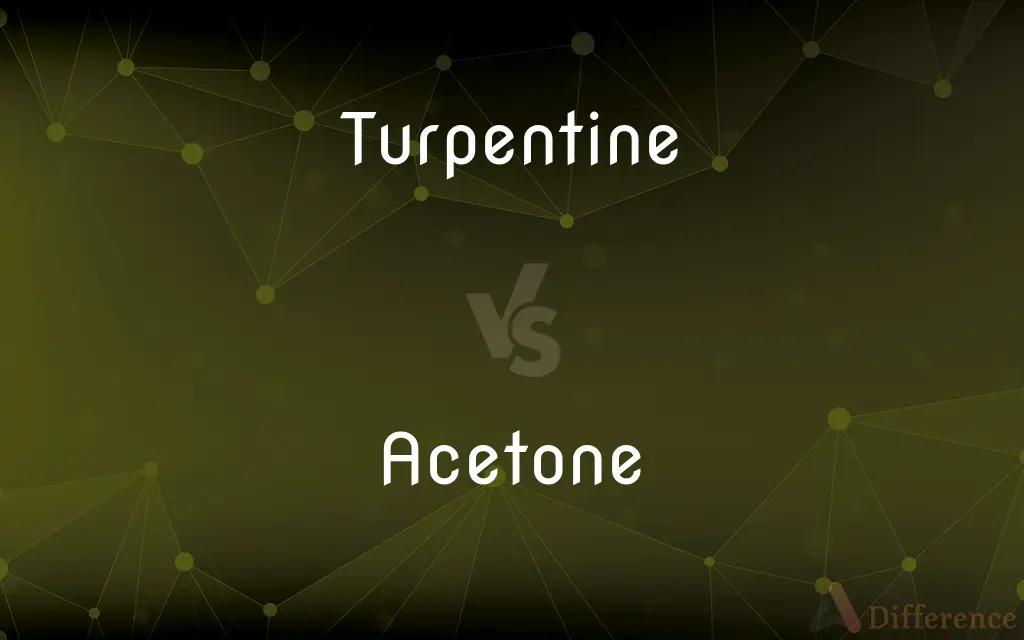Turpentine vs. Acetone — What's the Difference?
By Tayyaba Rehman & Fiza Rafique — Updated on March 24, 2024
Turpentine is a solvent derived from pine resin, used in paint thinners and varnishes, while acetone is a powerful, synthetic solvent used in nail polish remover and for cleaning.

Difference Between Turpentine and Acetone
Table of Contents
ADVERTISEMENT
Key Differences
Turpentine is obtained through the distillation of resin from live trees, particularly pines, and has a strong, distinctive smell. It is often used as a solvent in the production of varnishes, paints, and linseed oil products. On the other hand, acetone is a synthetic chemical solvent, known for its fast-evaporating property and its ability to dissolve a wide range of organic compounds. It is commonly found in nail polish remover, laboratory solvents, and as a cleaner for various materials.
Turpentine is less aggressive than acetone and is preferred in applications requiring a gentle solvent, particularly in the art restoration field, where it’s important to preserve the integrity of original materials. Whereas, acetone's potent dissolving power makes it the go-to choice for removing synthetic resins, fiberglass, and plastics without leaving a residue.
Acetone boasts a lower boiling point and faster evaporation rate compared to turpentine, which translates to quicker drying times for processes and coatings that utilize it. This feature makes acetone ideal for rapid-deploy applications in industrial and laboratory settings. Conversely, turpentine's slower evaporation rate is beneficial in applications like oil painting, where a slower drying time is desirable.
Safety and environmental considerations also differ markedly between the two. Turpentine vapors can be more hazardous to breathe over long periods, and it poses a greater risk in terms of flammability and environmental impact when disposed of improperly. Acetone, while also flammable, is less toxic to humans in controlled exposures and is considered more environmentally friendly due to its ability to break down more rapidly in nature.
Turpentine, being a natural product, varies in composition depending on the source of the pine resin, which can affect its solvency and behavior in applications. Acetone, on the other hand, is a consistent, man-made chemical, ensuring uniform performance and reliability across different batches and applications.
ADVERTISEMENT
Comparison Chart
Source
Derived from pine resin
Synthetic chemical solvent
Smell
Strong, distinctive
Sharp, pungent
Evaporation Rate
Slower
Faster
Toxicity
More toxic, especially with long exposure
Less toxic in controlled exposures
Application
Paint thinners, varnishes, art restoration
Nail polish remover, lab solvent, cleaner for plastics
Compare with Definitions
Turpentine
A substance used to thin oil-based paints or clean up after their use.
Turpentine serves as an effective paint thinner, reducing the viscosity of the paint for smoother application.
Acetone
A volatile, flammable liquid used to dissolve other chemical substances.
Acetone is widely used as an organic solvent in laboratories for its effectiveness and quick evaporation.
Turpentine
A product obtained through the distillation of resin from pine trees.
The artist preferred natural resin distillate like turpentine for its traditional qualities.
Acetone
A common household product for removing nail polish.
She used acetone-based nail polish remover to quickly clean off her old polish.
Turpentine
An ingredient in varnishes that enhances drying and aesthetic properties.
Turpentine was added to the varnish to improve its gloss and drying time.
Acetone
A solvent that efficiently cleans surfaces, particularly hard-to-remove residues.
Acetone was applied to clean the adhesive residue from the glass surface.
Turpentine
A gentle solvent used in the cleaning and restoration of artworks.
The restorer used turpentine carefully to remove the centuries-old varnish from the painting.
Acetone
A chemical used in scientific experiments for reactions or as a solvent.
The chemist used acetone as a laboratory reagent to dissolve organic samples.
Turpentine
A volatile pungent oil distilled from gum turpentine or pine wood, used in mixing paints and varnishes and in liniment.
Acetone
A solvent that dissolves certain plastics, useful in industrial processes.
Acetone can dissolve certain types of plastic, making it useful in recycling and reshaping processes.
Turpentine
A liquid substance capable of dissolving other substances without chemical alteration.
Turpentine is used as a solvent in oil painting to thin paints and clean brushes.
Acetone
Acetone, or propanone, is an organic compound with the formula (CH3)2CO. It is the simplest and smallest ketone. It is a colourless, highly volatile and flammable liquid with a characteristic pungent odour.
Turpentine
Turpentine (which is also called gum turpentine, spirit of turpentine, oil of turpentine, wood turpentine, terebenthene, terebinthine and (colloquially), turps) is a fluid obtained by the distillation of resin harvested from living trees, mainly pines. Mainly used as a specialized solvent, it is also a source of material for organic syntheses.
Acetone
(organic compound) A colourless, volatile, flammable liquid ketone, (CH3)2CO, used as a solvent.
Turpentine
Any of a number of trees which yield turpentine or a similar resin.
Acetone
A volatile liquid consisting of three parts of carbon, six of hydrogen, and one of oxygen; pyroacetic spirit, - obtained by the distillation of certain acetates, or by the destructive distillation of citric acid, starch, sugar, or gum, with quicklime.
Turpentine
Apply turpentine to
Antique turpentining equipment
Acetone
The simplest ketone; a highly inflammable liquid widely used as an organic solvent and as material for making plastics
Turpentine
A thin volatile terpenoid essential oil, C10H16, obtained by steam distillation or other means from the wood or exudate of certain pine trees and used as a paint thinner, solvent, and medicinally as a liniment. Also called oil of turpentine, spirit of turpentine.
Turpentine
The sticky mixture of resin and volatile oil from which turpentine is distilled.
Turpentine
A brownish-yellow resinous liquid obtained from the terebinth.
Turpentine
To apply turpentine to or mix turpentine with.
Turpentine
To extract turpentine from (a tree).
Turpentine
Any oleoresin secreted by the wood or bark of certain trees.
Turpentine
A volatile essential oil now obtained from such oleoresin of from the wood of pine trees by steam distillation; a complex mixture of monoterpenes; now used as a solvent and paint thinner.
Turpentine
(transitive) To drain resin from (a tree) for use in making turpentine.
Turpentine
A semifluid or fluid oleoresin, primarily the exudation of the terebinth, or turpentine, tree (Pistacia Terebinthus), a native of the Mediterranean region. It is also obtained from many coniferous trees, especially species of pine, larch, and fir.
Turpentine
Obtained from conifers (especially pines)
Turpentine
Volatile liquid distilled from turpentine oleoresin; used as paint thinner and solvent and medicinally
Common Curiosities
What is turpentine used for?
Turpentine is used as a solvent in paint thinners, varnishes, and in art restoration to clean and thin paints.
Can acetone and turpentine be used interchangeably?
While both are solvents, their different chemical properties and strengths make them suitable for specific applications, not always interchangeable.
What is the main difference between turpentine and acetone?
The main difference is their source and chemical composition: turpentine is derived from pine resin, while acetone is a synthetic chemical solvent.
Is acetone more toxic than turpentine?
Acetone is considered less toxic than turpentine in controlled exposures, but both are hazardous with improper handling.
What makes acetone a good nail polish remover?
Its ability to quickly dissolve synthetic resins and its fast evaporation rate make it effective and convenient.
Does turpentine have a strong smell?
Yes, turpentine has a strong, distinctive smell that is often associated with paint thinners.
Why is turpentine preferred in art restoration?
Its gentle solvent properties make it suitable for cleaning and restoring paintings without damaging the original materials.
What precautions should be taken when using turpentine?
Use in a well-ventilated area, wear protective gear, and avoid prolonged exposure to its fumes.
Can acetone dissolve organic compounds?
Yes, acetone is effective at dissolving a wide range of organic compounds, making it versatile for cleaning and solvent uses.
Are there environmental concerns associated with using turpentine?
Yes, improper disposal of turpentine can harm the environment due to its slower breakdown and higher toxicity.
How is acetone produced?
Acetone is produced synthetically through chemical processes, often as a by-product of phenol production.
Is turpentine considered environmentally friendly?
While natural, turpentine poses environmental risks due to its toxicity and should be disposed of properly to minimize it.
How does the evaporation rate of acetone compare to turpentine?
Acetone has a faster evaporation rate than turpentine, making it dry quicker.
Can turpentine be used on plastics like acetone?
Turpentine is generally not recommended for plastics as it is less effective and can damage certain types.
Is acetone flammable?
Yes, acetone is highly flammable and requires careful handling.
Share Your Discovery

Previous Comparison
Seismograph vs. Seismometer
Next Comparison
Backwash vs. SwashAuthor Spotlight
Written by
Tayyaba RehmanTayyaba Rehman is a distinguished writer, currently serving as a primary contributor to askdifference.com. As a researcher in semantics and etymology, Tayyaba's passion for the complexity of languages and their distinctions has found a perfect home on the platform. Tayyaba delves into the intricacies of language, distinguishing between commonly confused words and phrases, thereby providing clarity for readers worldwide.
Co-written by
Fiza RafiqueFiza Rafique is a skilled content writer at AskDifference.com, where she meticulously refines and enhances written pieces. Drawing from her vast editorial expertise, Fiza ensures clarity, accuracy, and precision in every article. Passionate about language, she continually seeks to elevate the quality of content for readers worldwide.
















































